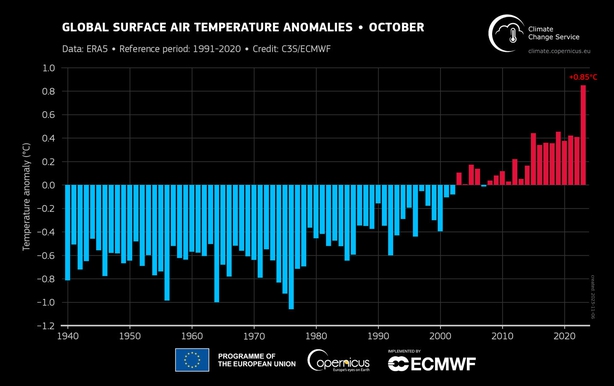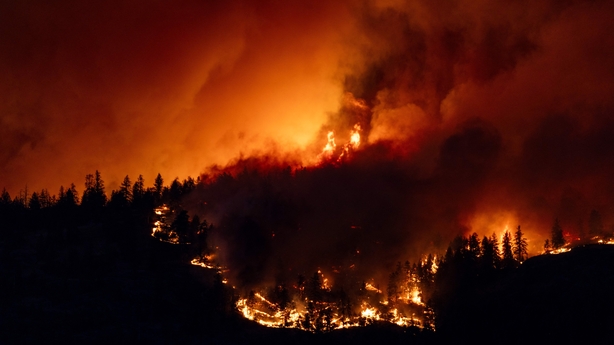2023 is "virtually certain" to be the warmest in 125,000 years, European Union scientists have said, after data showed last month was the world's hottest October in that period.
Last month smashed through the previous October temperature record, from 2019, by a massive margin, the EU's Copernicus Climate Change Service (C3S) said.
"The record was broken by 0.4 degrees Celsius, which is a huge margin," said C3S Deputy Director Samantha Burgess, who described the October temperature anomaly as "very extreme".
The heat is a result of continued greenhouse gas emissions from human activity, combined with the emergence this year of the El Nino weather pattern, which warms the surface waters in the eastern Pacific Ocean.
Globally, the average surface air temperature in October was 1.7 degrees Celsius warmer than the same month in 1850-1900, which Copernicus defines as the pre-industrial period.
The record-breaking October means 2023 is now "virtually certain" to be the warmest year recorded, C3S said in a statement. The previous record was 2016 - another El Nino year.

Copernicus' dataset goes back to 1940. "When we combine our data with the IPCC, then we can say that this is the warmest year for the last 125,000 years," Ms Burgess said.
The longer-term data from UN climate science panel IPCC includes readings from sources such as ice cores, tree rings and coral deposits.
The only other time before October a month breached the temperature record by such a large margin was in September 2023.

"September really, really surprised us. So after last month, it's hard to determine whether we're in a new climate state. But now records keep tumbling and they're surprising me less than they did a month ago," Burgess said.
Michael Mann, a climate scientist at University of Pennsylvania, said: "Most El Nino years are now record-breakers, because the extra global warmth of El Nino adds to the steady ramp of human-caused warming."
Climate change is fuelling increasingly destructive extremes. This year, that included floods that killed thousands of people in Libya, severe heatwaves in South America, and Canada's worst wildfire season on record.

"We must not let the devastating floods, wildfires, storms, and heatwaves seen this year become the new normal," said Piers Forster, climate scientist at University of Leeds.
"By rapidly reducing greenhouse gas emissions over the next decade, we can halve the rate of warming," he added.
Despite countries setting increasingly ambitious targets to gradually cut emissions, so far that has not happened. Global CO2 emissions hit a record high in 2022.
El Niño is expected to last until at least April 2024. It is expected to fuel temperature increases and exacerbate extreme weather and climate-events, like heatwaves, floods and droughts.
— World Meteorological Organization (@WMO) November 8, 2023
New WMO Updatehttps://t.co/l5VJXkRf5K#StateofClimate #EarlyWarningsForAll pic.twitter.com/PnagiJVUQU
The United Nations said the El Nino weather phenomenon is expected to last until at least April 2024.
The UN's World Meteorological Organization said the current El Nino, which developed rapidly during July-August this year, was likely to peak between now and January.
"There is a 90% likelihood it will persist throughout the upcoming northern hemisphere winter/southern hemisphere summer," it said in its latest update, adding that it was expected to last until at least April.
The weather phenomenon typically occurs every two to seven years, and it usually increases global temperatures in the year after it develops.
But, while most of the El Nino impact is not expected to be felt until 2024, WMO highlighted that the phenomenon was occurring in the context of rapid climate change.
El Nino last occurred in 2018-2019 and was followed by an exceptionally long La Nina - El Nino's cooling opposite - which ended earlier this year.
WMO said the most recent forecasts for the current El Nino impact suggest a high likelihood of continued warming in the central-eastern equatorial Pacific through next April.
Other impacts are likely to include above-normal rainfall in the Horn of Africa region and the La Plata basin in South America and in southeastern North America, as well as in parts of central and eastern Asia.
The north of South America, much of Australia and the Pacific islands are meanwhile set to see less rain, according to the predictions.


